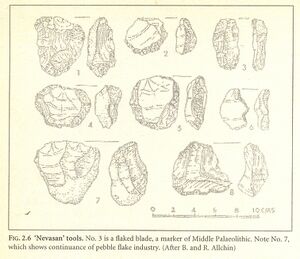Hathnora Sehore
| Author:Laxman Burdak, IFS (Retd.) |


Hathnora (हथनौरा) is a village in Budni tahsil in Sehore district in Madhya Pradesh.
Prehistory

Irfan Habib[2] writes that...[p.26] Many sites in south India including Hunsgi valley in Karnataka, and Attirampakkam, near Chennai, have turned up “Early Acheulean tools” (of the so -
[p.27]: called 'Madras industry'), that is, hand axes, etc., made mainly from the cores (see Fig. 2.5).

The U-Th method has yielded dates going back to beyond 350,000 years for sites in Karnataka. Lower Palaeolithic artefacts at Didwana in Rajasthan have been dated by the same means to 390,000 years ago, and at Nevasa in Ahmadnagar district of Maharashtra to 350,000 years ago.
During this process of his diffusion there was a tendency over time for the original Homo erectus to evolve into sub-species that were less robust but more dexterous, and so could make smaller tools out of flakes or the 'Late Acheulean tools'. Remains of such tools have been found in the Narmada valley, where these appear in association with the 'Narmada skull' discovered at Hathnora. This skull, belonging to an evolved Homo erectus could date back to a time earlier than 130,000 years ago. At the famous cave of Bhimbetka in the same area, successive periods of occupation begin with the lowest floors containing Late Acheulean tools.
As Homo erectus evolved, he also improved his tools, giving them new shapes and adjusting the technique to locally available materials. Such changes occurred very slowly, over tens of thousands of years, but these ultimately led to the rise of regional 'cultures'. The term 'culture' is used when archaeologists find at a layer in one or more sites a similar assemblage of tools, ornaments and other products of human labour, which they call 'artefacts', as well as indications of similar customs and beliefs, such as systems of disposing of the dead, and ritual symbols. Regarding Homo erectus, there is little known of custom or belief, and the forms of his stone tools alone supply us with clues to his varied cultures. As the millennia passed, the tendency was for the production of smaller and thinner tools; and the apparently independent appearances of the flake blade in many parts of the world were a natural result of such a tendency. The flake blade is supposed to mark the Middle Palaeolithic stage in India. Such stone blades are found in the 'Nevasa culture' (named after the site of Nevasa already mentioned), which seems to have extended over the southern peninsula and central India (see Fig. 2.6).

At Didwana, the Middle Paeolithic is dated by the TL method to about 150.000 years, ago, but in Gujarat a date as late as 56,800 years ago has been obtained by the U-Th method. In Sri Lanka's southern wet zone, a range of 200,000 to 40,000 years ago has been suggested for it. So the culture may have lasted for a hundred thousand years, if not more. This culture is held to be in direct continuity with the Lower Palaeolithic; and, therefore, its authors were probably the direct descendants of the late Homo erectus, though no skeletal remains have yet been found at any of the sites.
History
Location
ग्राम हथनोरा जिला मुख्यालय बुधनी से 37 किलोमीटर और जिला मुख्यालय सीहोर से 130 किलोमीटर की दूरी पर अवस्थित है । यह ग्राम पंचायत गांव है । इसके आसपास के गांव है- रामपुरा, जवाहर खेड़ा , पिपलिया खर्रा ,सुदानिया, जैत, डोबी, बिनेका आदि
Population
वर्ष 2011 की जनगणना के अनुसार यहां की कुल जनसंख्या 1126 है जिसमें पुरुष 573 महिलाएं 553 हैं और 251 परिवार निवासरत है ।
Notable persons
- श्री माधोसिंह जाट
- श्रीनन्दन सिंह पटेल, पूर्व सरपंच -9827119434
- इंजी.नृपेंद्र सिंह 9131686621
- चेन सिंह जाट
- यशवंतसिंह जाट - 9981803331
Jat gotras
- Lalauलालऊ
External links
Source
- Santosh Kumar Thakur (Khenwar) 9826546968
References
- ↑ People’s History of India 1, Prehistory, by Irfan Habib, Aligarh Historians Society, Published by Tulika Books, Second Edition, 2002, ISBN: 81-85229-68-6,p.26-27
- ↑ People’s History of India 1, Prehistory, by Irfan Habib, Aligarh Historians Society, Published by Tulika Books, Second Edition, 2002, ISBN: 81-85229-68-6,p.26-27
Back to Jat Villages

